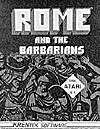
Programmed by Steve Krentek
Krentek Software
P.O. Box 3372, Kansas City, KS 66103
Price: $34.95
Complexity: Advanced
Solitaire Suitability: Very Good
***
Rome and the Barbarians is a long-range strategic game about the fall of Rome. Your objective is to drive off the invading barbarian hordes and save Roman Civilization in the century of A.D. 400-500. This game is programmed for the ATARI and requires only 32K of memory for the disk version.
Rome and the Barbarians just misses being a very good game. it has all the elements of a good grandstrategic level game, but an unfortunate omission in the options available to the player makes the game a race to enter orders instead of a carefully crafted strategy game. The play of the game is continuous, with no "turns" as such. Both your units and the enemy's Move whenever you display the map. What the game desperately needs is a "freeze" command that would allow you to assess the entire situation and issue orders without having the situation change. As it is, the task of finding out what is happening conflicts with tactical necessities. Still, with practice, it is one of the better games available for machines with limited memory.
Rome and the Barbarians encompasses all of Europe with a smooth, scrolling map. The map is visually unimpressive. The sea and mountainous terrain are represented in blue and green. Cities are marked by bright dots on the screen, and the units of the friendly and enemy sides by square symbols, gold for friendly and blue for enemy. Both friendly and enemy units come in several varieties: Roman and mixed (R), Barbarian (B), and revolting locals (L). Unfortunately, it is not possible to determine any more than the general unit type from the screen. To determine a unit's contents, you must select it with the joystick, wasting precious time.
Orders are entered by a combination of joystick and keyboard. To issue movement orders to a unit, you position the cursor on top of the unit to be moved, press the button, and then move the joystick in the desired direction. It is important to coordinate the forces moving into battle so that they arrive at a battle simultaneously. At the same time, it is necessary to garrison cities, both to collect taxes and to keep allied tribes happy. To leave garrisons behind, you must position the cursor on top of the unit in question and press the SELECT key. An economic status screen is also available by pressing the OPTION key. This allows the player to bribe barbarian tribes and to hire barbarian mercenaries. It is also necessary to keep your own units from getting too big, because a general of a large force may decide that he can do a better job of running the Empire than you can, and may revolt.
All of the above are reasonable strategic considerations, but the game fails in one important way. While you are trying to decide what to do and maneuvering the joystick from unit to unit, play is continually progressing. The bad guys are always on the move, and it is very hard to coordinate tactical considerations of beating them with strategic concerns of maintaining the Empire. The net result is a kind of "information overload" that makes the game difficult to play. I feel that the game would be considerably improved if there were a way to stop play while surveving the situation and issuing orders.
The only way it is possible to freeze play is to bring up the economic status display, from which no movement orders can be issued. You tend to lose track of the total situation very quickly while you are trying to juggle things. Although it is undoubtedly possible to master this game after sufficient practice, I think that this serious design fault could have been easily rectified. There are two different games, the "beginner's" game and the "standard" game. The problems of play coordination are common to both versions. It is possible to save a game in progress and also bring up an essentially useless example," which only allows you to display the map without units.
In conclusion, this game has some good ideas, but the poor coordination between the strategic considerations, tactical necessities, and the order giving process makes it difficult to play. if you have a memory-limited machine, however, you might like to take a look at the game just because of the dearth of good strategic games available. With sufficient practice, this game could he a worthwhile investment.
More War Game Reviews
-
Game Review: Napoleon's Last Battles: Quadrigame of the Waterloo Campaign
Game Review: Rome and the Barbarians
Game Review: Warhammer: Fantasy Battle Rules, Second Edition
Game Review: Lebensraum: The Campaign in the East, 1941-1945
Game Review: Pax Brittanica: The Colonial Era from 1880 to The Great War
Back to Table of Contents -- Game News #7
To Game News List of Issues
To MagWeb Master Magazine List
© Copyright 1985 by Dana Lombardy.
This article appears in MagWeb (Magazine Web) on the Internet World Wide Web.
Other military history articles and gaming articles are available at http://www.magweb.com